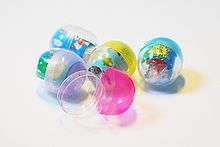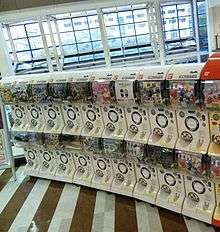Gashapon

The terms gashapon (ガシャポン) or gachapon (ガチャポン) refer to variety of vending machine-dispensed capsule toys popular in Japan and elsewhere. "Gashapon" is a Japanese onomatopoeia composed of two sounds: "gasha" (or "gacha") for the sound of a crank on a toy vending machine, and "pon" for the sound of the toy capsule dropping into the receptacle. Gashapon may describe both the machines themselves and the toys obtained from them. Popular manufacturers of gashapon include Tomy, which uses the shortened term Gacha (ガチャ gacha) for their capsule machines, and Kaiyodo. In the United States, "Gashapon" is a registered trademark of the Bandai Company,[1] and gashapon are generally referred to as blind box sets.
Description
Gashapon machines are similar to the coin-operated toy vending machines seen outside of grocery stores and other retailers in other countries. While American coin-operated vending toys are usually cheap, low-quality products sold for a few quarters (US$1 or less), Japanese gashapon can cost anywhere from ¥100–500 (US$1–6) and are normally a much higher-quality product. They are often constructed from high-grade PVC plastic, and contain more molding detail and intricately painted features. Many gashapon are considered collector's items, with rare ones fetching extremely high prices in secondhand markets.[2]
Gashapon toys are often licensed from popular characters in Japanese manga, video games or anime, or from the American entertainment industry. These highly detailed toys have found a large following among all generations in Japan, and the trend is filtering to the world, especially among adult collectors. It is not uncommon for sets marketed specifically for adults to feature risqué female figurines.[3]

.jpg)
Virtually all gashapon are released in sets—each series will have a number of figures to collect. They are, by nature, a "blind purchase"; people insert coins and hope to get the toy or figure they desire. Such an amusement element may become frustrating, as one risks obtaining the same capsule repeatedly.
Enthusiastic collectors will buy sets from gashapon stores in places such as Tokyo's Akihabara or Osaka's Nipponbashi (Den-Den Town). Depending on the store, the sets are usually cheaper than buying them randomly out of a machine.
Types of gashapon
Blind-boxes
In recent years, the term gashapon has also come to refer to blind-box trading figures, which are essentially the same product sold randomly out of sealed packages instead of a machine.[4]
Bottle cap figures
Another variety of gashapon is bottle cap figures. These small figures are mounted atop a plastic bottle cap, as might be found on a twenty-ounce soda bottle. They are sold both in machine capsules and blind boxes. The caps are not fully functional as they do not have screw threads to secure them to the mouth of the bottle.
Video games
Gashapon machines and their random payouts have inspired trinket-collection mini-games in many video games, most notably the Legend of Zelda series' similarly named "Gasha Trees" in Oracle of Ages and Oracle of Seasons, and, to a much higher extent, the random figurine payout in The Minish Cap. Gashapon have also appeared in some Mario games such as Mario Party 5 and well as Super Smash Bros. Melee where the player inserts a desired amount of coins and gets a trophy of a Nintendo-related nature in return. In both The Minish Cap and Super Smash Bros. Melee, the more the player spends in one go, the higher the chance of getting a new item in return. The bonus stage in Sonic the Hedgehog 3 is also gashapon inspired.
The gashapon concept is taken to the next level in SD Gundam Gashapon Wars, a game based on the SD Gundam television series, in which a gamer can activate extra characters from the game by buying certain series of SD Gundam gashapon toys in real life, namely SD Full Color STAGE:61, then use the password bundled with the toy to unlock the corresponding character in the video game. This is the same marketing tactic used by Kinder Surprise for the online surprises, except there is no online access involved.
Many free-to-play MMOs and mobile games have mechanics inspired by gashapons, with randomly generated items of varying market values being acquired via microtransactions.
- In the NES game Mega Man 4 there is an enemy named Gachappon which is a Gashapon vending machine modified to shoot energy shots and other kinds of projectiles.
- The Chip Trader from the Mega Man Battle Network series functions similarly to gashapon machines.
- In the online massively multiplayer online game PangYa the gashapon is a small Adobe Flash-powered mini-game in which users buy coins using real money, and in turn will give out items ranging from common, low-value items to rare, high-value items. There is also a consistent theme of gashapon items being released in sets, much like their real-life counterparts.
- The machines also appear in the Dreamcast game Shenmue, in which the main character Ryo Hazuki could spend yen to collect various figurines, including series of characters from the Virtua Fighter and Sonic the Hedgehog series of games as well as those of other known and lesser known Sega franchises (i.e. Fantasy Zone, Space Harrier, Hang-On etc.).
- The GameCube game Gotcha Force is completely based on gashapon toys, pitting a massive variety of capsule toy-sized/themed aliens (called Borgs) against each other and the Galactic Emperor. As you progress, you earn new fighters that open from capsules, some of which require multiple parts to complete. Tying into the capsule toy theme even more are the variants that come in a range of styles from an alternate coloring to completely transparent to solid silver, gold, and black versions.
- In Mega Man X: Command Mission, gashapon machines can be found in various places, and contain figures of various Mega Man characters.
- They are also seen in killer7, in which all of the figures are required to open a specific door.
- During the course of Resident Evil 4, the player can take part in a shooting range mini-game to unlock models of characters and enemies that are viewable in the Keys/Treasure inventory. There is one figure in each set that requires a higher score to unlock, which could be considered the 'rare' figures. This is also done in Resident Evil 5, which models of characters and enemies are unlocked for viewing by obtaining Completion Points.
- In Kingdom Hearts II, there is a rare type of Heartless called the "Bulky Vendor," based on a gashapon machine. Only appearing in certain areas of some worlds, its HP bar drops quickly and it jumps and moves faster as time goes on. The player is required to catch up with it and use a Reaction command, from 'Capsule Prize' up to 'Prime Capsule' to receive a capsule which explodes into orbs and an item prize. This is the only way (besides treasure chests) to gain the valuable Orichalcum item.
- The PSP game Work Time Fun consists of nothing but playing small mini-games for money to spend in gashapon machines. The machines deposit trinkets whose descriptions often poke fun at common gashapon trinkets.
- In the original Yu-Gi-Oh series (referred to as season zero by most fans) and its related manga, there were a series of episodes where players played a game called Capsule Monsters (Capmon for short) that involved the use of a Gashapon machine to obtain the game pieces in which players used. Mokuba is seen playing this game the most, and is usually Yugi's enemy when it comes to playing this game. In a series later on that was released after the final episodes, there was a special movie that used these Capsule Monsters as a main part of the game. However, unlike the other Capsule Monsters, these ones were made out of bronze or gold, and were shot out from a capsule shooter to battle. The series that was released in English has nothing to do with the original.
- In Pokémon XD: Gale of Darkness there are gashapon machines in the stores such as the PokéMart in Pyrite Town that appear to have Poké Balls inside. Poké Balls are inspired by the capsules for gashapon machines.
- Gashapon is also used in the Naruto Ultimate Ninja series, the player earns yen by completing tasks in which allows him to put money in the machine; the more money the player puts in, the more likely he will get a gashapon it is used for getting miniature figurines, soundtracks, and collectible cards in-game.
- In Tales of Vesperia on both the isle of Nam Cobanda and at the Yumanju hot springs there are Gachapon machines which on rare occasion give out figurines for a sidequest.
- The Crank-a-Kai machine in Level 5's Yo-Kai Watch is a capsule machine, from which the main character indirectly receives the titular device. By inserting coins the player can obtain capsules containing items, or Yokai who were supposedly sealed away. In homage to this, Yo-Kai Watch merchandise can be found in Gashapon machines in Japan. There is also a Yo-Kai who presides over the world's Gashapon machines, including the Crank-a-Kai. It fights using capsules obtained within its own personal Gashapon machine.
Gashapon-style item distribution has been adopted by many massively multiplayer online games, particularly those using the free-to-play model as a form of premium transaction made with real money, often granting access to items exclusive to that system.
- In the online massively multiplayer online game MapleStory the gashapon is used as a gambling type machine, wherein players can purchase with real money tickets which, when used at the gashapon, will allow the player to receive a random item of random value.
- Similarly, in Mabinogi, the premium shop sells gashapon items that hold a variety of in-game items the player can use, such as dyes or armor as well as exclusively colored items and exclusive armor and clothing.
- The MMO known as Cosmic Break uses a Gashapon machine called "Garapon". It has 5 rarities signified by the color of the capsule. Gold is the highest rarity in the game. However, the Garapon is highly controversial due to the pricing and extremely low chance of obtaining these items. It usually costs $3–$5 per spin, as such, due to rarity issues, people have had to spend over $200 (and over $1000 in some rare cases) in order to get just one gold capsule.
- In Second Life, many stores run by users of the game have created their own Gashapon style devices called 'Gacha' that sell random objects in their shops.[5]
- In the online game of TinierMe, they have their own Gachapon (Gacha) machines for users to gain the majority of their items from, and a Complete Gacha for people who finish the Gachapon.
- in Digimon Masters Online, An MMO originally created by Digitalic and now owned by Move Games, They use Gachapon Coins on a vending machine that has a chance to give one of four colored capsule's and rarity goes from green, yellow, blue and purple.
See also
References
- ↑ http://trademarks.justia.com/781/58/gashapon-78158256.html
- ↑ "What is a gacha gacha?". Gacha Gacha World. 2013-02-15. Retrieved 2013-02-24.
- ↑ "Curiosities from Japan's porno shops". demonbaby. 2005-08-22. Retrieved 2013-01-16.
- ↑ "Astro Toy with Rob Bricken: Dragonball x One Piece Dream Fusion". Anime News Network. Retrieved 2013-01-16.
- ↑ Crazy Cute Mesh Hamster Avatars Take SL by Storm!, New World Notes, 21 September 2012
| Wikimedia Commons has media related to Capsule toys. |